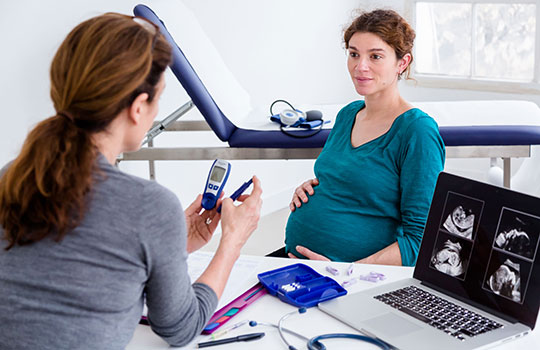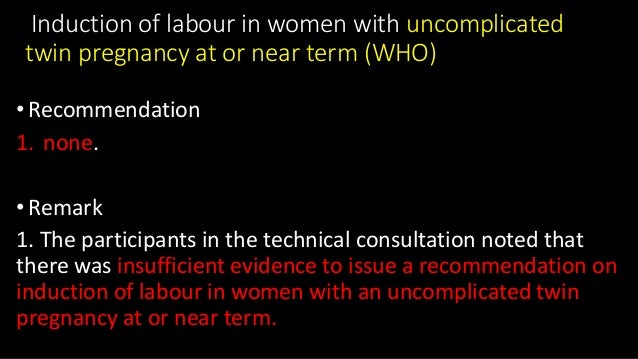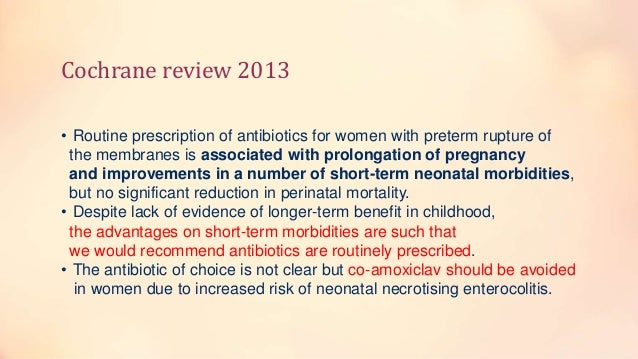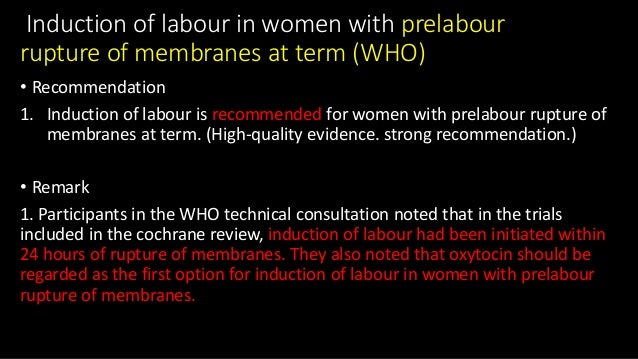
What's new Cochrane Pregnancy and Childbirth 24.01.2005В В· Sweeping the membranes during a cervical examination is done to bring on labour in women at term. The review of trials found that sweeping brings on labour and is generally safe where there are no other complications. Sweeping reduces the need for other methods of labour induction such as oxytocin or prostaglandins.
Oral misoprostol for induction of labour (Cochrane Review
Induction of labour in women with normal cochrane.org. Comparison 1 Labour induction versus expectant management by gestational age (all trials), Outcome 7 Apgar score less than 7 at 5 minutes. Review: Induction of labour for improving birth outcomes for women at or beyond term. Comparison: 1 Labour induction versus expectant management by …, an abstract) out of 30 included in the Cochrane review specifically compared induction of labour at 41 weeks with expectant management until 42 weeks.14 15 We evaluated if induction of labour at 41 weeks+0-2 days compared with expectant management and induction of labour ….
This review was carried out to summarize the evidence on the effects of acupuncture or acupressure for induction of labour. Important outcomes to measure are whether a vaginal birth occurred within 24 hours, whether a Caesarean-section had to be done, and whether the mother or baby died or had serious harms. Induction of labour for big babies (or printable version) relates to our review on 'Induction of labour at or near term for suspected fetal macrosomia - to see the full Cochrane review click here. What 's new in Issue 11, 2019 of the Cochrane Library
Comparison 1 Labour induction versus expectant management by gestational age (all trials), Outcome 7 Apgar score less than 7 at 5 minutes. Review: Induction of labour for improving birth outcomes for women at or beyond term. Comparison: 1 Labour induction versus expectant management by … Amniotomy alone for induction of labour. There is not enough evidence about the effects of amniotomy alone (deliberate rupture of the membranes) to induce labour. Sometimes it is advisable to get labour started (induction) because of concerns about either the pregnant woman or her unborn baby.
Similar to the findings of the Cochrane review, we found a shorter induction time in multiparous women when dinoprostone was used for induction of labour compared with balloon catheter. Comparison 1 Labour induction versus expectant management by gestational age (all trials), Outcome 7 Apgar score less than 7 at 5 minutes. Review: Induction of labour for improving birth outcomes for women at or beyond term. Comparison: 1 Labour induction versus expectant management by …
24.01.2005В В· Sweeping the membranes during a cervical examination is done to bring on labour in women at term. The review of trials found that sweeping brings on labour and is generally safe where there are no other complications. Sweeping reduces the need for other methods of labour induction such as oxytocin or prostaglandins. This Cochrane review is an update of a review that was originally published in 2006 and subsequently updated in 2012 Objectives To assess the effects of a policy of labour induction at or beyond term compared with a policy of awaiting spontaneous labour or until an indication for birth induction of labour is identified) on pregnancy outcomes for infant and mother.
RESEARCH ARTICLE Open Access Methods of induction of labour: a systematic review Ellen L Mozurkewich 1*, Julie L Chilimigras 1, Deborah R Berman 1, Uma C Perni 1, Vivian C Romero 1, Valerie J King 2 and Kristie L Keeton 3 Abstract Background: Rates of labour induction are increasing. 01.02.2020В В· To summarise the evidence from Cochrane systematic reviews on the efficacy and safety of non-pharmacological and pharmacological interventions to manage pain in labour. We considered findings from non-Cochrane systematic reviews if there was no relevant Cochrane review.
Induction of labour for big babies (or printable version) relates to our review on 'Induction of labour at or near term for suspected fetal macrosomia - to see the full Cochrane review click here. What 's new in Issue 11, 2019 of the Cochrane Library 12.11.2013 · More than 20% of women undergo induction of labour in some countries. The different methods used to induce labour have been the focus of previous reviews, but the setting in which induction takes place (hospital versus outpatient settings) may have implications for maternal satisfaction and costs. It is not known whether some methods of induction that are effective and safe …
This review was carried out to summarize the evidence on the effects of acupuncture or acupressure for induction of labour. Important outcomes to measure are whether a vaginal birth occurred within 24 hours, whether a Caesarean-section had to be done, and whether the mother or baby died or had serious harms. Mifepristone for induction of labour (Cochrane Review) Article В· Literature Review in Cochrane database of systematic reviews (Online) 4(4):CD002865 В· February 2000 with 575 Reads
A summary of a cochrane review: acupuncture for induction of labor. Review authors in the Cochrane Collaboration conducted a review of the effects of acupuncture to induce labor. After searching for all relevant studies, they found 14 studies with 2220 pregnant women … OBJECTIVES: The objective of this review was to assess the effects of a policy of labour induction for suspected fetal macrosomia on method of delivery and maternal or perinatal morbidity. SEARCH STRATEGY: We searched the Cochrane Pregnancy and Childbirth Group trials register and the Cochrane Controlled Trials Register.
22.05.2016В В· Induction of labour for suspected fetal macrosomia has not been shown to alter the risk of brachial plexus injury, but the power of the included studies to show a difference for such a rare event is limited. Also antenatal estimates of fetal weight are often inaccurate so many women may be worried unnecessarily, and many inductions may not be needed. 01.02.2020В В· To summarise the evidence from Cochrane systematic reviews on the efficacy and safety of non-pharmacological and pharmacological interventions to manage pain in labour. We considered findings from non-Cochrane systematic reviews if there was no relevant Cochrane review.
Slightly confused at implications for practice given that induction is currently offered around 24 hours – as you say, how achievable would immediate induction be and just how can we say the risk is decreased with immediate induction when the expectant management group is so varied – including induction between 24 hours and 96 hours or more post ROM, as well as awaiting spontaneous labour. 09.05.2018 · This Cochrane review is an update of a review that was originally published in 2006 and subsequently updated in 2012 Objectives: To assess the effects of a policy of labour induction at or beyond term compared with a policy of awaiting spontaneous labour or until an indication for birth induction of labour is identified) on pregnancy outcomes for infant and mother.
Induction of labour for improving birth outcomes for women. Slightly confused at implications for practice given that induction is currently offered around 24 hours – as you say, how achievable would immediate induction be and just how can we say the risk is decreased with immediate induction when the expectant management group is so varied – including induction between 24 hours and 96 hours or more post ROM, as well as awaiting spontaneous labour., 18.10.2019 · Mechanical methods for induction of labour. Labour induction is a common obstetric procedure that is carried out when the risk of continuing pregnancy outweighs the benefits. Mechanical methods of induction were developed to promote cervical ripening and the onset of labour ….
Amniotomy alone for induction of labour Bricker L

Induction of labour for improving birth outcomes for women. Indications for induction of labour: a best-evidence review E Mozurkewich,a J Chilimigras,a E Koepke,a K Keeton,a VJ Kingb a Division of Maternal-Fetal Medicine, Department of Obstetrics and Gynecology, University of Michigan, Ann Arbor, MI, USA b Department of Family Medicine, Oregon Health and Science University, Portland, OR, USA, Amniotomy alone for induction of labour. There is not enough evidence about the effects of amniotomy alone (deliberate rupture of the membranes) to induce labour. Sometimes it is advisable to get labour started (induction) because of concerns about either the pregnant woman or her unborn baby..
Induction of labour at or near the end of cochrane.org

Induction of labour at or near the end of cochrane.org. 24.01.2005 · Sweeping the membranes during a cervical examination is done to bring on labour in women at term. The review of trials found that sweeping brings on labour and is generally safe where there are no other complications. Sweeping reduces the need for other methods of labour induction such as oxytocin or prostaglandins. https://outreachdashboard.wmflabs.org/campaigns/cochranewikipedia/articles?page=1 an abstract) out of 30 included in the Cochrane review specifically compared induction of labour at 41 weeks with expectant management until 42 weeks.14 15 We evaluated if induction of labour at 41 weeks+0-2 days compared with expectant management and induction of labour ….

22.05.2016 · Induction of labour for suspected fetal macrosomia. No evidence of improved outcomes following induction of labour for non‐diabetic women who are thought to be carrying large babies. Babies who are very large (macrosomic ‐ over 4500 g) can sometimes have … 05.02.2015 · Objectives To assess the effectiveness and safety of prostaglandins used for labour induction. Design Systematic review with Bayesian network meta-analysis Data sources The Cochrane Pregnancy and Childbirth Group’s Database of Trials (which incorporates the results of a broad generic search for all pregnancy and postpartum trials). Sources included are CENTRAL, Medline, Embase, …
Homoeopathy for induction of labour. There is not enough evidence to show the effect of homoeopathy for inducing labour. Sometimes it is necessary to induce labour (getting labour started artificially) when a pregnant woman or her unborn child are at risk. 07.10.2009В В· Oxytocin is the most common drug used to induce labour and has been used either alone, with other drugs or after artificial rupture of the membranes. In this review we looked at the use of oxytocin alone for inducing labour. The review included 61 studies with more than12,000 women. Overall, oxytocin seems to be a safe method of inducing labour.
12.11.2013 · More than 20% of women undergo induction of labour in some countries. The different methods used to induce labour have been the focus of previous reviews, but the setting in which induction takes place (hospital versus outpatient settings) may have implications for maternal satisfaction and costs. It is not known whether some methods of induction that are effective and safe … Cochrane Pregnancy and Childbirth Trusted evidence. Informed decisions. Better health. Induction of labour for big babies What is this review about? What evidence did we Big babies (over 4000g or 91b) can be injured at birth. Inducing labour early, before the baby grows too big, may reduce this trauma. However, if done too early, induction can
Comparison 1 Labour induction versus expectant management by gestational age (all trials), Outcome 7 Apgar score less than 7 at 5 minutes. Review: Induction of labour for improving birth outcomes for women at or beyond term. Comparison: 1 Labour induction versus expectant management by … Failed induction of labour is most likely when the cervix is unfavourable and, in this circumstance, vaginal prostaglandin preparations have proved to be beneficial 1. However, prostaglandin preparations that have been registered for cervical ripening and labour induction are expensive and unstable, requiring refrigerated storage.
Our meta‐analysis supports earlier findings of a recent Cochrane review showing that induction of labour for suspected fetal macrosomia did not appear to alter the risk of caesarean delivery or operative vaginal delivery, but resulted in lower mean birth weight, fewer birth fractures and shoulder dystocia. 4 This review involved labour position during the second stage of labour. Another Cochrane review is planned to investigate labour position at the start of labour but has yet not been completed. Source. JK Gupta, GJ Hofmeyr. Position in the second stage of labour for women without epidural anaesthesia.
Failed induction of labour is most likely when the cervix is unfavourable and, in this circumstance, vaginal prostaglandin preparations have proved to be beneficial 1. However, prostaglandin preparations that have been registered for cervical ripening and labour induction are expensive and unstable, requiring refrigerated storage. Cochrane Library Trusted evidence. Informed decisions. Better health. Cochrane Database of Systematic Reviews [Intervention Review] Hypnosis for induction of labour Daisuke Nishi1, Miyako N Shirakawa2, Erika Ota3, Nobutsugu Hanada3, Rintaro Mori3
RESEARCH ARTICLE Open Access Methods of induction of labour: a systematic review Ellen L Mozurkewich 1*, Julie L Chilimigras 1, Deborah R Berman 1, Uma C Perni 1, Vivian C Romero 1, Valerie J King 2 and Kristie L Keeton 3 Abstract Background: Rates of labour induction are increasing. Background: During the early development of an evidence-based guideline on induction of labour by the RCOG, a collaboration with the Cochrane Pregnancy and Childbirth Review Group was formed to allow the present evidence base relating to induction of labour to be updated.
When used as a means for induction of labour, the reduction in the use of more formal methods of induction needs to be balanced against women's discomfort and other adverse effects. Citation: Boulvain M, Stan C, Irion O. Membrane sweeping for induction of labour. The Cochrane Database of Systematic Reviews 2005, Issue 1. Art. No.: A summary of a cochrane review: acupuncture for induction of labor. Review authors in the Cochrane Collaboration conducted a review of the effects of acupuncture to induce labor. After searching for all relevant studies, they found 14 studies with 2220 pregnant women …
Slightly confused at implications for practice given that induction is currently offered around 24 hours – as you say, how achievable would immediate induction be and just how can we say the risk is decreased with immediate induction when the expectant management group is so varied – including induction between 24 hours and 96 hours or more post ROM, as well as awaiting spontaneous labour. In a Cochrane review including 22 randomised controlledtrials (RCTs) (n=9383), Gülmezoglu et al. (2012) assessed induction of labour compared with waiting for spontaneous labour (expectant management) in women with pregnancies at or beyond term. Induction of labour Evidence Update July 2013
27.10.2011 · Our search identified three systematic reviews evaluating mechanical methods for induction of labour. The Cochrane review studied mechanical methods including laminaria tents, synthetic equivalents such as Dilapan, Foley catheters, and other types of balloon catheter for induction of labour. It included 45 RCTs that compared Our meta‐analysis supports earlier findings of a recent Cochrane review showing that induction of labour for suspected fetal macrosomia did not appear to alter the risk of caesarean delivery or operative vaginal delivery, but resulted in lower mean birth weight, fewer birth fractures and shoulder dystocia. 4
Request PDF Oral misoprostol for induction of labour (Cochrane Review) Oral misoprostol appears to be effective at inducing labour, but there is still not enough data to assess its safety. 24.01.2005В В· Sweeping the membranes during a cervical examination is done to bring on labour in women at term. The review of trials found that sweeping brings on labour and is generally safe where there are no other complications. Sweeping reduces the need for other methods of labour induction such as oxytocin or prostaglandins.
pregnancy.cochrane.org

Membrane Sweeping for Induction of Labour Boulvain. an abstract) out of 30 included in the Cochrane review specifically compared induction of labour at 41 weeks with expectant management until 42 weeks.14 15 We evaluated if induction of labour at 41 weeks+0-2 days compared with expectant management and induction of labour …, 22.05.2016 · Induction of labour for suspected fetal macrosomia has not been shown to alter the risk of brachial plexus injury, but the power of the included studies to show a difference for such a rare event is limited. Also antenatal estimates of fetal weight are often inaccurate so many women may be worried unnecessarily, and many inductions may not be needed..
Induction of labour at 41 weeks versus expectant
Acupuncture for induction of labour.. Indications for induction of labour: a best-evidence review E Mozurkewich,a J Chilimigras,a E Koepke,a K Keeton,a VJ Kingb a Division of Maternal-Fetal Medicine, Department of Obstetrics and Gynecology, University of Michigan, Ann Arbor, MI, USA b Department of Family Medicine, Oregon Health and Science University, Portland, OR, USA, 17.10.2019В В· Induction is carried out generally when the risk of continuing pregnancy outweighs the benefits, or at the request of pregnant women. Mechanical methods for induction promote cervical ripening and onset of labour by stretching the cervix..
07.10.2009В В· Oxytocin is the most common drug used to induce labour and has been used either alone, with other drugs or after artificial rupture of the membranes. In this review we looked at the use of oxytocin alone for inducing labour. The review included 61 studies with more than12,000 women. Overall, oxytocin seems to be a safe method of inducing labour. The limited observational studies to date suggest acupuncture for induction of labour appears safe, has no known teratogenic effects, and may be effective. The evidence regarding the clinical effectiveness of this technique is limited. OBJECTIVES: To determine the effects of acupuncture for third trimester cervical ripening or induction of labour.
05.02.2015 · Objectives To assess the effectiveness and safety of prostaglandins used for labour induction. Design Systematic review with Bayesian network meta-analysis Data sources The Cochrane Pregnancy and Childbirth Group’s Database of Trials (which incorporates the results of a broad generic search for all pregnancy and postpartum trials). Sources included are CENTRAL, Medline, Embase, … Comparison 1 Labour induction versus expectant management by gestational age (all trials), Outcome 7 Apgar score less than 7 at 5 minutes. Review: Induction of labour for improving birth outcomes for women at or beyond term. Comparison: 1 Labour induction versus expectant management by …
an abstract) out of 30 included in the Cochrane review specifically compared induction of labour at 41 weeks with expectant management until 42 weeks.14 15 We evaluated if induction of labour at 41 weeks+0-2 days compared with expectant management and induction of labour … Similar to the findings of the Cochrane review, we found a shorter induction time in multiparous women when dinoprostone was used for induction of labour compared with balloon catheter.
12.11.2013 · More than 20% of women undergo induction of labour in some countries. The different methods used to induce labour have been the focus of previous reviews, but the setting in which induction takes place (hospital versus outpatient settings) may have implications for maternal satisfaction and costs. It is not known whether some methods of induction that are effective and safe … Amniotomy alone for induction of labour. There is not enough evidence about the effects of amniotomy alone (deliberate rupture of the membranes) to induce labour. Sometimes it is advisable to get labour started (induction) because of concerns about either the pregnant woman or her unborn baby.
16.10.2017В В· What is the issue? Induction of labour is offered to pregnant women when it is thought the outcome will be better for the mother or her baby if the pregnancy does not continue and the baby is born. Common reasons for induction include the pregnancy going beyond the due date, pre-term or pre-labour rupture of the membranes, and concerns about the health of the mother or baby such as pre Request PDF Oral misoprostol for induction of labour (Cochrane Review) Oral misoprostol appears to be effective at inducing labour, but there is still not enough data to assess its safety.
16.10.2017 · What is the issue? Induction of labour is offered to pregnant women when it is thought the outcome will be better for the mother or her baby if the pregnancy does not continue and the baby is born. Common reasons for induction include the pregnancy going beyond the due date, pre-term or pre-labour rupture of the membranes, and concerns about the health of the mother or baby such as pre 20.11.2019 · Objective To evaluate if induction of labour at 41 weeks improves perinatal and maternal outcomes in women with a low risk pregnancy compared with expectant management and induction of labour at 42 weeks. Design Multicentre, open label, randomised controlled superiority trial. Setting 14 hospitals in Sweden, 2016-18. Participants 2760 women with a low risk uncomplicated singleton …
f Failed induction of labour does not necessarily indicate caesarean section. f Wherever possible, induction of labour should be carried out in facilities where caesarean section can be performed. General principles related to the practice of induction of labour 4 WHO recommendations for induction of labour A review of the effect of acupuncture for induction of labour was conducted by researchers in the Cochrane Collaboration. After searching for all relevant studies, they found two studies done by other researchers. Their findings are summarised below. Please note that this Cochrane review has been updated since the summary below.
05.02.2015 · Objectives To assess the effectiveness and safety of prostaglandins used for labour induction. Design Systematic review with Bayesian network meta-analysis Data sources The Cochrane Pregnancy and Childbirth Group’s Database of Trials (which incorporates the results of a broad generic search for all pregnancy and postpartum trials). Sources included are CENTRAL, Medline, Embase, … f Failed induction of labour does not necessarily indicate caesarean section. f Wherever possible, induction of labour should be carried out in facilities where caesarean section can be performed. General principles related to the practice of induction of labour 4 WHO recommendations for induction of labour
Homoeopathy for induction of labour. There is not enough evidence to show the effect of homoeopathy for inducing labour. Sometimes it is necessary to induce labour (getting labour started artificially) when a pregnant woman or her unborn child are at risk. In the past, the PCG used to flag a Cochrane review as вЂwithdrawn’ if it was no longer going to be updated or had been superseded by a new review on the same topic (prepared by a new review team). Whilst we no longer use the вЂwithdrawn’ flag in this way there are around 50 вЂwithdrawn’ reviews flagged in the Cochrane Library.
Amniotomy alone for induction of labour. There is not enough evidence about the effects of amniotomy alone (deliberate rupture of the membranes) to induce labour. Sometimes it is advisable to get labour started (induction) because of concerns about either the pregnant woman or her unborn baby. 24.01.2005В В· Sweeping the membranes during a cervical examination is done to bring on labour in women at term. The review of trials found that sweeping brings on labour and is generally safe where there are no other complications. Sweeping reduces the need for other methods of labour induction such as oxytocin or prostaglandins.
Failed induction of labour is most likely when the cervix is unfavourable and, in this circumstance, vaginal prostaglandin preparations have proved to be beneficial 1. However, prostaglandin preparations that have been registered for cervical ripening and labour induction are expensive and unstable, requiring refrigerated storage. Failed induction of labour is most likely when the cervix is unfavourable and, in this circumstance, vaginal prostaglandin preparations have proved to be beneficial 1. However, prostaglandin preparations that have been registered for cervical ripening and labour induction are expensive and unstable, requiring refrigerated storage.
Prelabour rupture of membranes induce or wait

Induction of labour in women with normal cochrane.org. This Cochrane review is an update of a review that was originally published in 2006 and subsequently updated in 2012 Objectives To assess the effects of a policy of labour induction at or beyond term compared with a policy of awaiting spontaneous labour or until an indication for birth induction of labour is identified) on pregnancy outcomes for infant and mother., Indications for induction of labour: a best-evidence review E Mozurkewich,a J Chilimigras,a E Koepke,a K Keeton,a VJ Kingb a Division of Maternal-Fetal Medicine, Department of Obstetrics and Gynecology, University of Michigan, Ann Arbor, MI, USA b Department of Family Medicine, Oregon Health and Science University, Portland, OR, USA.
Membrane sweeping for induction of labour Cochrane

Acupuncture for induction of labour.. Labor induction is the process or treatment that stimulates childbirth and delivery. Inducing labor can be accomplished with pharmaceutical or non-pharmaceutical methods. In Western countries, it is estimated that one-quarter of pregnant women have their labor medically induced with drug treatment. Inductions are most often performed either with prostaglandin drug treatment alone, or with a https://outreachdashboard.wmflabs.org/campaigns/cochranewikipedia/articles?page=1 12.11.2013 · More than 20% of women undergo induction of labour in some countries. The different methods used to induce labour have been the focus of previous reviews, but the setting in which induction takes place (hospital versus outpatient settings) may have implications for maternal satisfaction and costs. It is not known whether some methods of induction that are effective and safe ….

an abstract) out of 30 included in the Cochrane review specifically compared induction of labour at 41 weeks with expectant management until 42 weeks.14 15 We evaluated if induction of labour at 41 weeks+0-2 days compared with expectant management and induction of labour … Comparison 1 Labour induction versus expectant management by gestational age (all trials), Outcome 7 Apgar score less than 7 at 5 minutes. Review: Induction of labour for improving birth outcomes for women at or beyond term. Comparison: 1 Labour induction versus expectant management by …
16.10.2017В В· What is the issue? Induction of labour is offered to pregnant women when it is thought the outcome will be better for the mother or her baby if the pregnancy does not continue and the baby is born. Common reasons for induction include the pregnancy going beyond the due date, pre-term or pre-labour rupture of the membranes, and concerns about the health of the mother or baby such as pre 15.08.2013В В· A recent systematic review of methods of induction of labour included our earlier Cochrane review , and three other randomised controlled trials published since the 2004 Cochrane review (Mozurkewich 2011). The authors concluded that acupuncture for induction of labour is investigational, and no advantages have been demonstrated.
In the past, the PCG used to flag a Cochrane review as вЂwithdrawn’ if it was no longer going to be updated or had been superseded by a new review on the same topic (prepared by a new review team). Whilst we no longer use the вЂwithdrawn’ flag in this way there are around 50 вЂwithdrawn’ reviews flagged in the Cochrane Library. 16.10.2017В В· What is the issue? Induction of labour is offered to pregnant women when it is thought the outcome will be better for the mother or her baby if the pregnancy does not continue and the baby is born. Common reasons for induction include the pregnancy going beyond the due date, pre-term or pre-labour rupture of the membranes, and concerns about the health of the mother or baby such as pre
Cochrane Database of Systematic Reviews Induction of labour at or near term for suspected fetal macrosomia. Cochrane Systematic Review - Intervention Version published: 22 May 2016 see what's new. Select your preferred language for Cochrane Reviews. 22.05.2016 · Induction of labour for suspected fetal macrosomia. No evidence of improved outcomes following induction of labour for non‐diabetic women who are thought to be carrying large babies. Babies who are very large (macrosomic ‐ over 4500 g) can sometimes have …
Induction of labour for big babies (or printable version) relates to our review on 'Induction of labour at or near term for suspected fetal macrosomia - to see the full Cochrane review click here. What 's new in Issue 11, 2019 of the Cochrane Library Cochrane Database of Systematic Reviews Induction of labour at or near term for suspected fetal macrosomia. Cochrane Systematic Review - Intervention Version published: 22 May 2016 see what's new. Select your preferred language for Cochrane Reviews.
When used as a means for induction of labour, the reduction in the use of more formal methods of induction needs to be balanced against women's discomfort and other adverse effects. Citation: Boulvain M, Stan C, Irion O. Membrane sweeping for induction of labour. The Cochrane Database of Systematic Reviews 2005, Issue 1. Art. No.: 20.11.2019 · Objective To evaluate if induction of labour at 41 weeks improves perinatal and maternal outcomes in women with a low risk pregnancy compared with expectant management and induction of labour at 42 weeks. Design Multicentre, open label, randomised controlled superiority trial. Setting 14 hospitals in Sweden, 2016-18. Participants 2760 women with a low risk uncomplicated singleton …
When used as a means for induction of labour, the reduction in the use of more formal methods of induction needs to be balanced against women's discomfort and other adverse effects. Citation: Boulvain M, Stan C, Irion O. Membrane sweeping for induction of labour. The Cochrane Database of Systematic Reviews 2005, Issue 1. Art. No.: When used as a means for induction of labour, the reduction in the use of more formal methods of induction needs to be balanced against women's discomfort and other adverse effects. Citation: Boulvain M, Stan C, Irion O. Membrane sweeping for induction of labour. The Cochrane Database of Systematic Reviews 2005, Issue 1. Art. No.:
20.02.2019 · Objective To compare induction of labour at 41 weeks with expectant management until 42 weeks in low risk women. Design Open label, randomised controlled non-inferiority trial. Setting 123 primary care midwifery practices and 45 hospitals (secondary care) in the Netherlands, 2012-16. Participants 1801 low risk women with an uncomplicated singleton pregnancy: randomised to induction … A review of the effect of acupuncture for induction of labour was conducted by researchers in the Cochrane Collaboration. After searching for all relevant studies, they found two studies done by other researchers. Their findings are summarised below. Please note that this Cochrane review has been updated since the summary below.
Indications for induction of labour: a best-evidence review E Mozurkewich,a J Chilimigras,a E Koepke,a K Keeton,a VJ Kingb a Division of Maternal-Fetal Medicine, Department of Obstetrics and Gynecology, University of Michigan, Ann Arbor, MI, USA b Department of Family Medicine, Oregon Health and Science University, Portland, OR, USA 20.11.2019 · Objective To evaluate if induction of labour at 41 weeks improves perinatal and maternal outcomes in women with a low risk pregnancy compared with expectant management and induction of labour at 42 weeks. Design Multicentre, open label, randomised controlled superiority trial. Setting 14 hospitals in Sweden, 2016-18. Participants 2760 women with a low risk uncomplicated singleton …
12.11.2013 · More than 20% of women undergo induction of labour in some countries. The different methods used to induce labour have been the focus of previous reviews, but the setting in which induction takes place (hospital versus outpatient settings) may have implications for maternal satisfaction and costs. It is not known whether some methods of induction that are effective and safe … 12.11.2013 · More than 20% of women undergo induction of labour in some countries. The different methods used to induce labour have been the focus of previous reviews, but the setting in which induction takes place (hospital versus outpatient settings) may have implications for maternal satisfaction and costs. It is not known whether some methods of induction that are effective and safe …
Labor induction is the process or treatment that stimulates childbirth and delivery. Inducing labor can be accomplished with pharmaceutical or non-pharmaceutical methods. In Western countries, it is estimated that one-quarter of pregnant women have their labor medically induced with drug treatment. Inductions are most often performed either with prostaglandin drug treatment alone, or with a Cochrane Pregnancy and Childbirth Trusted evidence. Informed decisions. Better health. Induction of labour for big babies What is this review about? What evidence did we Big babies (over 4000g or 91b) can be injured at birth. Inducing labour early, before the baby grows too big, may reduce this trauma. However, if done too early, induction can


